Xbox
Xbox is a video gaming brand created and owned by Microsoft. It represents a series of video game consoles developed by Microsoft, with three consoles released in the sixth, seventh, and eighth generations, respectively. The brand also represents applications (games), streaming services, an online service by the name of Xbox Live, and the development arm by the name of Xbox Game Studios. The brand was first introduced in the United States in November 2001, with the launch of the original Xbox console.
.svg.png) | |
| Product type | Video gaming |
|---|---|
| Owner | Microsoft |
| Country | Microsoft Redmond Campus, Redmond, Washington, United States |
| Introduced | November 15, 2001 |
| Markets | Worldwide |
| Registered as a trademark in | Worldwide |
| Website | www |
The original device was the first video game console offered by an American company after the Atari Jaguar stopped sales in 1996. It reached over 24 million units sold as of May 2006.[1] Microsoft's second console, the Xbox 360, was released in 2005 and has sold 84 million units as of June 2014. The Xbox One has been released in 21 markets in total, with a Chinese release in September 2014. The head of Xbox is Phil Spencer, who succeeded former head Marc Whitten in late March 2014.[2][3]
Consoles
First generation: Xbox
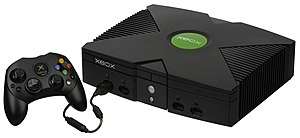
The original Xbox was released on November 15, 2001, in North America, February 22, 2002, in Japan, and March 14, 2002, in Australia and Europe. It was Microsoft's first foray into the gaming console market. As part of the sixth-generation of gaming, the Xbox competed with Sony's PlayStation 2, Sega's Dreamcast (which stopped American sales before the Xbox went on sale), and Nintendo's GameCube. The Xbox was the first console offered by an American company after the Atari Jaguar stopped sales in 1996. The name Xbox was derived from a contraction of DirectX Box, a reference to Microsoft's graphics API, DirectX.[4][5]
The integrated Xbox Live service launched in November 2002 allowed players to play games online with or without a broadband connection.[6] It first competed with Dreamcast's online service but later primarily competed with PlayStation 2's online service. Although these two are free while Xbox Live required a subscription, as well as broadband-only connection which was not completely adopted yet, Xbox Live was a success due to better servers, features such as a buddy list, and milestone titles like Halo 2 released in November 2004, which is the best-selling Xbox video game and was by far the most popular online game for the system.
Second generation: Xbox 360
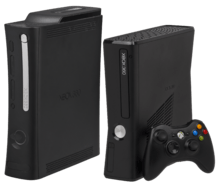
The Xbox 360 was released as the successor of the original Xbox in November 2005, competing with Sony's PlayStation 3 and Nintendo's Wii as part of the seventh generation of video game consoles. As of June 30, 2013, 78.2 million Xbox 360 consoles have been sold worldwide.[7] The Xbox 360 was officially unveiled on MTV on May 12, 2005, with detailed launch and game information divulged later that month at the Electronic Entertainment Expo (E3). The console sold out completely upon release in all regions except in Japan.[8][9][10] Several retail configurations of the core Xbox 360 model were offered over its lifetime, varying the amount of RAM and internal storage offered.
The Xbox 360 showed an expanded Xbox Live service (which now included a limited "Free" tier called Silver), the ability to stream multimedia content from PCs, while later updates added the ability to purchase and stream music, television programs, and films through the Xbox Music and Xbox Video services, along with access to third-party content services through third-party media streaming applications. Microsoft also released Kinect, a motion control system for the Xbox 360 which uses an advanced sensor system.
Two major revisions of the Xbox 360 were released following the initial launch. The Xbox 360 S (typically considered as "Slim"), launched in 2010, featured the same core hardware but with a redesigned, slimmer form factor with a smaller-sized 250 GB hard drive. It also added integrated 802.11 b/g/n Wi-Fi, TOSLINK S/PDIF optical audio output, five USB 2.0 ports (compared to the three from older versions) and special port designed for the Kinect peripheral. The Xbox 360 S replaced the base Xbox 360 unit, which was discontinued, and sold at the same price.[11][12][13] A cheaper Xbox 360 S unit, removing the 250 GB drive while adding 4 GB of internal store, was released later in 2010; the unit allowed users to hook up an external storage solution or purchase a 250 GB internal add-on.
The second major revision of the Xbox 360 was the Xbox 360 E, released in 2013. It featured a case style similar to the upcoming Xbox One, and eliminated one USB port and the S/PDIF, YPbPr component and S-video connections, but otherwise shared the same specifications as the Xbox 360 S.
Third generation: Xbox One
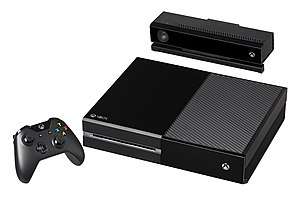
The Xbox One was released on November 22, 2013, in North America, as the successor of the Xbox 360. The Xbox One competes with Sony's PlayStation 4 and Nintendo's Wii U and Switch as part of the eighth generation of video game consoles.
Announced on May 21, 2013,[14] the Xbox One has an emphasis on internet-based features, including the ability to record and stream gameplay, and the ability to integrate with a set-top box to watch cable or satellite TV through the console with an enhanced guide interface and Kinect-based voice control.[15][16][17][18]
Following its unveiling, the Xbox One proved controversial for its original digital rights management and privacy practices; while Microsoft touted the ability for users to access their library of games (regardless of whether they were purchased physically or digitally) on any Xbox One console without needing their discs, and the ability to share their entire library with 10 designated "family" members, all games would have to be tied to the user's Xbox Live account and their Xbox One console, and the console would be required to connect to the Internet on a periodic basis (at least once every 24 hours) to synchronize the library, or else the console would be unable to play any games at all.[19][20] After an overwhelmingly negative response from critics and consumers (who also showed concerns that the system could prevent or hinder the resale of used games), Microsoft announced that these restrictions would be dropped.[21] Microsoft was also criticized for requiring the Xbox One to have its updated Kinect peripheral plugged in to function, which critics and privacy advocates believed could be used as a surveillance device. As a gesture toward showing a commitment to user privacy, Microsoft decided to allow the console to function without Kinect.[22][23][24]
On June 13, 2016, Microsoft announced the Xbox One S at E3 2016, which featured a smaller form factor, as well as support for 4K video (including streaming and Ultra HD Blu-ray) and HDR.[25] At E3 2017, Microsoft unveiled Xbox One X, a high-end model with improved hardware designed to facilitate the playing of games at 4K resolution.[26]
Fourth generation: Xbox
During The Game Awards 2019, Microsoft officially unveiled Xbox Series X—a new Xbox model to be released in November 2020.[27] The console is estimated to be four times as powerful as Xbox One X, with support for 8K resolution, real-time ray-tracing, and 120 frames-per-second rendering. Xbox Series X is stated to be backwards compatible with all games and accessories currently compatible with Xbox One (including original Xbox and Xbox 360 titles that are supported on Xbox One).[28] While most first-party games will be released for both the Xbox One and the new console with a free upgrade path in the console's launch window via Microsoft's Smart Delivery system, later first-party games were being developed for the Xbox Series X first with Xbox One functionaly to be added if appropriate.[29][30]
Following the unveiling, a Microsoft spokesperson stated that Xbox Series X constituted an entry in a fourth generation of Xbox hardware, which will be branded simply as "Xbox" with no subtitle.[31] Prior to the E3 reveal, it had been speculated that Microsoft was developing two next-generation Xbox consoles codenamed "Anaconda" and "Lockhart", which were high-end and low-end models respectively. Microsoft has focused solely on a high-end product in its current marketing.[32][33] As the launch of the Xbox Series X approach, more details about this second console appeared from internal Microsoft document stating a lower-power version likely using the name "Xbox Series S" as to align with the third generation of the Xbox console line.[34][35]
Comparison
The following table is a comparison of the first three generations of Xbox hardware.
| Xbox generation | First | Second | Third | Fourth | ||
|---|---|---|---|---|---|---|
| Xbox | Xbox 360 | Xbox One | Xbox One S | Xbox One X | Xbox Series X | |
| Console | 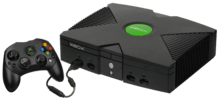 |
 |
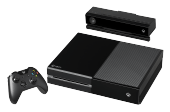 |
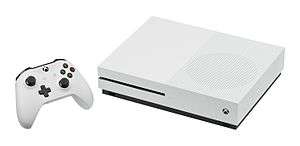 |
.jpg) |
|
| Console launch price | US$299.99 | US$299.99 Further information: Xbox 360 launch#Release dates and pricing |
|
|
US$499.99 | N/A |
| Release date |
|
|
November 22, 2013[36] |
|
November 7, 2017 | November 2020 |
| Discontinued |
|
|
|
|
N/A | |
| Units sold[lower-alpha 1] | 24+ million (as of May 10, 2006)[1] | 84+ million (as of June 9, 2014)[37](details) | 26+ million (estimate, as of January 18, 2017)[38] | N/A | N/A | |
| Best-selling game | Halo 2, 8 million (as of May 9, 2006)[39][40] | Kinect Adventures! (pack-in with Kinect peripheral), 24 million[41]
Best selling non-bundled game: Call of Duty: Modern Warfare 3, 14.23 million[42] |
Call of Duty: Black Ops III, 7.24 million (As of October 16, 2016)[43] | N/A | ||
| Media | CD, DVD | CD, DVD, HD DVD (movies only) with add-on drive, USB Drive with supported media, DLNA Servers[44] | CD, DVD, Blu-ray Disc, USB Drive with supported media, DLNA Servers[44] | CD, DVD, Blu-ray Disc, UHD Blu-ray Disc, USB Drive with supported media, DLNA Servers[45] | CD, DVD, Blu-ray Disc, UHD Blu-ray Disc, USB Drive with supported media, DLNA Servers, Proprietary 1TB SSD Extended Storage | |
| Accessories (retail) |
see Xbox 360 accessories |
see Xbox One accessories | ||||
| CPU | 733 MHz x86 Intel Celeron/Pentium III Custom Hybrid CPU | 3.2 GHz IBM PowerPC tri-core CPU codenamed "Xenon" | 1.75 GHz AMD x86-64 eight-core CPU codenamed "Jaguar"[46] | 2.3 GHz semi-custom AMD x86-64 eight-core CPU code named "Jaguar Enhanced"[45] | 3.8 GHz custom AMD Zen 2 eight-core CPU[47] | |
| GPU | 233 MHz nVidia custom GeForce 3 NV2A DirectX 8.0 based GPU | 500 MHz ATi custom Radeon X1800 DirectX 9.0c based GPU codenamed "Xenos" | 853 MHz AMD Radeon HD 7000 series DirectX 11.1, DirectX 12 based GPU codenamed "Durango" with 12 compute units | 914 MHz AMD Radeon HD 7000 series DirectX 11.1, DirectX 12 based GPU codenamed "Edmonton" with 12 compute units | 1172 MHz AMD GCN DirectX 11.1, DirectX 12 based GPU codenamed "Scorpio" with 40 compute units | 1825 MHz AMD Custom RDNA 2 DirectX 12 based CPU with 52 compute units[47] |
| Memory | 64 MB DDR SDRAM @ 200 MHz 6.4 GB/s | 512 MB of GDDR3 RAM @ 700 MHz 22.4 GB/s, 10 MB EDRAM GPU frame buffer memory | 8 GB of DDR3 RAM @ 2133 MHz 68.3 GB/s,[44] 32 MB ESRAM GPU frame buffer memory | 12 GB of GDDR5 RAM @ 6.8 GHz 326 GB/s[45] | 16 GB of GDDR6 RAM; 10 GB @ 560 GB/s, 6 GB @ 336 GB/s[47] | |
| Video I/O ports |
|
|
|
| ||
| Video resolution and features |
Various monitor resolutions available via VGA and HDMI/DVI (640×480, 848×480, 1024×768, 1280×720, 1280×768, 1280×1024, 1360×768, 1440×900, 1680×1050 & 1920×1080) |
|
|
|||
| Video codecs supported |
??? |
N/A | ||||
| Audio I/O |
|
|
|
|
| |
| Audio formats and features |
|
|
N/A | |||
| Audio codecs supported |
??? |
N/A | ||||
| Online service | Xbox Live (2002–10) XLink Kai (2003–present) |
Xbox Live Xbox Live Arcade Xbox Live Marketplace Xbox Live Vision (webcam), headset Xbox Live Video Marketplace Windows Live Messenger Internet Explorer VideoKinect (Kinect sensor is no longer needed) |
Xbox Live Xbox Store Microsoft Store Internet Explorer Microsoft Edge Skype |
Xbox Live | ||
| Backward compatibility | N/A | 50% of Xbox Library | Select Xbox 360 and Xbox titles[48] |
| ||
| System software | Xbox Music Mixer DVD Playback Kit, Xbox Linux |
see Xbox 360 system software | see Xbox One system software | N/A | ||
| System software features |
|
|
||||
| Consumer programmability | Via Softmods and/or modchips; Modified Windows CE 2.x, Linux. | Development on PC with XNA Game Studio ($99/year subscription, binary distribution with XNA 1.0 Refresh).[51] | ID@Xbox and approved Microsoft Store; UWP apps. | |||
Future
Microsoft has been recently working to leverage the branding of "Xbox" beyond the console hardware but as a general video game brand, reflected in the renaming of Microsoft Studios to Xbox Game Studios in 2019.[52][53] Phil Spencer had stated in June 2019 that for Microsoft, "The business isn’t how many consoles you sell. The business is how many players are playing the games that they buy, how they play." which journalists have taken as a route to de-emphasize console hardware and prioritize games, subscriptions and services for players.[54][55] Later in February 2020, Spencer said that moving forward, the company does not see "traditional gaming companies" like Nintendo and Sony as their competitors but instead those that offer cloud computing services such as Amazon and Google. Spencer identified that Microsoft Azure is a major component of their plans going forward, which powers its xCloud game streaming service.[56] Spencer also cited mobile gaming as a potential area, and where Microsoft was trying to position itself with its services should this become the more preferred form for gaming. Spencer said "I don't think it's 'hardware agnostic' as much as it's 'where you want to play'", in describing how Microsoft was strategizing the Xbox branding for the future.[57]
Games
Each console has a variety of games. Most games released on the original Xbox are backwards compatible and can be played directly on its successor, Xbox 360. Backward compatibility with Xbox 360 titles was added to Xbox One in June 2015, although titles requiring Kinect or USB peripherals will not be supported.
Services
Xbox Live
Xbox Live is an online service with over 65 million users worldwide (as of July 2019).[58] It comprises an online virtual market, the Xbox Live Marketplace, which allows the purchase and download of games and various forms of multimedia. Online gaming on the Xbox first started on November 15, 2002 worldwide. The service is still active and continues to be played by gamers.
Xbox Live Marketplace
The Xbox Live Marketplace (XBLM) is a virtual market designed for Microsoft's Xbox 360 console that allows Xbox Live members to download purchased or promotional content. The service offers movie and game trailers, Video Store, game demos, Xbox Live Arcade games, Xbox Live Indie Games (Previously Community Games), Games on Demand (Xbox 360 and Xbox Originals), downloadable content such as map packs, gamer pictures, and Xbox 360 Dashboard themes.
The August 11, 2009 update added Xbox 360 games for download, the Avatar Marketplace, and renamed Community Games to Indie Games.
The Spring 2007 update to the Xbox 360 Dashboard relocated the Marketplace to its own "blade" in order to bring more attention to the service and make it more accessible to users. Although this has been obsoleted by the NXE update, the section has been implemented into three separate sections in the Dashboard: the Game Marketplace, Video & Music Marketplace, and Avatar Marketplace.
Downloaded content requires enough space on either the Xbox 360's hard drive, or an Xbox 360 Memory Unit. Selected downloads are placed in a queue and are downloaded whilst the console is powered on and is connected to Xbox Live. Users can choose to send certain downloads to the front of the queue to be downloaded first. Downloads are temporarily halted during certain times where games make use of Xbox Live's features (e.g. online multiplayer).
Xbox SmartGlass
Xbox SmartGlass is a companion application for Xbox 360 available for Windows 8, Windows 10, Windows Phone, iOS, Android (version 4.0 and above),[59] and Windows Server 2012. It was announced by Microsoft during E3 2012 and released on October 26, 2012, coinciding with the release of Windows 8.[60] It connects with the Xbox 360 and allows more interactive entertainment, allowing mobile devices to potentially serve as second screens and remote controller. Currently Windows 8 and Windows RT Tablets and PCs, Windows Phone (7.5 and 8) iOS devices, and Android smartphones (4.x) are compatible with SmartGlass,[61] providing information such as Halo 4 stats and Forza Horizon GPS.[62] Users of Windows Server 2012 can currently download the application from the Windows Store after installing the Windows Desktop Experience feature in the Server Manager.[63]
xCloud
xCloud is the working title of Microsoft's Xbox cloud gaming streaming service.
Content filter
In 2019, Microsoft released a content filtering to stop swearing and toxicity in online gaming. The service enable players to report messages, Gamertags, photos, and any other toxic content on its platform.[64]
Xbox Game Pass
Xbox Game Pass is a subscription service from Microsoft for use with its Xbox One and Windows 10. Described as "Netflix for video games",[65] the Xbox Game Pass grants users access to a catalog of games from a range of publishers for a single monthly subscription price. The service was launched on June 1, 2017.
Software
Xbox 360 Dashboard
The Xbox 360's original graphical user interface was the Xbox 360 Dashboard; a tabbed interface that featured five "Blades" (formerly four blades), and was designed by AKQA and Audiobrain. It could be launched automatically when the console booted without a disc in it, or when the disc tray was ejected, but the user had the option to select what the console does if a game is in the tray on start up, or if inserted when already on. A simplified version of it was also accessible at any time via the Xbox Guide button on the gamepad. This simplified version showed the user's gamercard, Xbox Live messages and friends list. It also allowed for personal and music settings, in addition to voice or video chats, or returning to the Xbox Dashboard from the game.
Xbox One Dashboard
Xbox Family Settings App
In May 2020, Xbox presented a preview version of an app that allows parents and guardians to set daily limits for their children's playing time, provides weekly activity reports, filters out age-restricted games, and places limits on online communication. This is the attempt of Microsoft, Xbox's owner, to promote a message of responsible gaming. The full release is expected in the end of 2020 or later.[66]
Controllers
Xbox Controller
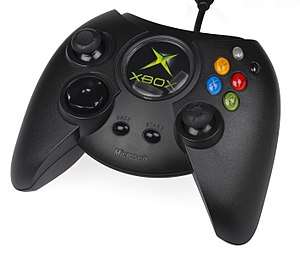
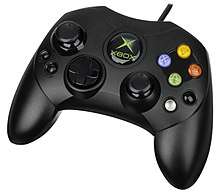
Released in 2001, the Xbox control pad was the first controller made for the original Xbox. The Xbox controller features two analog sticks, a pressure-sensitive directional pad, two analog triggers, a Back button, a Start button, two accessory slots and six 8-bit analog action buttons (A/Green, B/Red, X/Blue, Y/Yellow, and Black and White buttons).[67] The standard Xbox controller (originally nicknamed the "Fatty"[68] and later the "Duke"[69]) was originally the controller bundled with Xbox systems for all territories except Japan.
Xbox 360 Controller
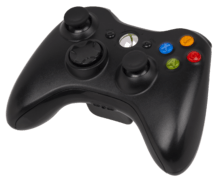
Released in 2005, the Xbox 360 controller for the Xbox 360 succeeded its predecessor. A standard Xbox 360 controller features eleven digital buttons, two analog triggers, two analog sticks and a digital D-pad. The right face of the controller features four digital action buttons; a green "A" button, red "B" button, blue "X" button and yellow "Y" button. The lower right houses the right analog stick, in lower left is a digital D-pad and on the left face is the left analog stick. Both analog sticks can also be "clicked in" to activate a digital button beneath. In the center of the controller face are digital "Start", "Back" and "Guide" buttons. The "Guide" button is labelled with the Xbox logo, and is used to turn on the console/controller and to access the guide menu. It is also surrounded by the "ring of light", which indicates the controller number, as well as flashing when connecting and to provide notifications. The left and right "shoulders" each feature a digital shoulder button, or "bumper", and an analog trigger.
Xbox 360 Kinect

Kinect (stylized as KINECT) is a motion sensing input device by Microsoft for the Xbox 360 video game console and Windows PCs. Based around a webcam-style add-on peripheral for the Xbox 360 console, it enables users to control and interact with the Xbox 360 without the need to touch a game controller, through a natural user interface using gestures and spoken commands.[70] The project is aimed at broadening the Xbox 360's audience beyond its typical gamer base.[71] Kinect competes with the Wii Remote Plus and PlayStation Move with PlayStation Eye motion controllers for the Wii and PlayStation 3 home consoles, respectively. A version for Windows was released on February 1, 2012.[72]
Kinect was launched in North America on November 4, 2010,[73] in Europe on November 10, 2010,[74] in Australia, New Zealand and Singapore on November 18, 2010,[75][76][77] and in Japan on November 20, 2010.[78] Purchase options for the sensor peripheral include a bundle with the game Kinect Adventures and console bundles with either a 4 GB[79][80][81] or 250 GB[82] Xbox 360 console and Kinect Adventures.[79][80][81][82]
The Kinect claimed the Guinness World Record of being the "fastest selling consumer electronics device" after selling a total of 8 million units in its first 60 days.[83][84][85] 24 million units of the Kinect sensor had been shipped as of January 2012.[41]
Microsoft released Kinect software development kit for Windows 7 on June 16, 2011.[86][87][88] This SDK was meant to allow developers to write Kinecting apps in C++/CLI, C#, or Visual Basic .NET.[89][90]
Additional information on the Xbox One Kinect was released on June 6, 2013, including information on how to turn off the "always on" feature.[91]
Xbox One Controller
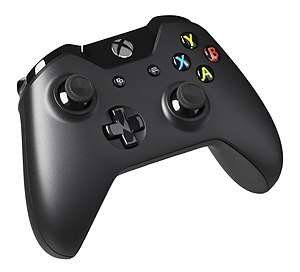
The Xbox One console has a revised controller with forty improvements over the 360's controller. This new controller is built to work with Kinect. The Start and Back buttons are replaced with Menu and View buttons. It has impulse triggers that replace the regular triggers. The button with the Xbox logo will no longer bring up the Xbox Guide as the Xbox Guide Button on the Xbox 360 controller did. The button will now open up the dashboard without interrupting the game currently being played by the user. Once pressed again, the Xbox will resume the game.[92]
Xbox One Kinect
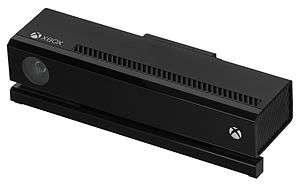
Although featuring improved performance over the original Xbox 360 Kinect, its successor the Xbox One Kinect was subject to mixed responses. It was praised for its wide-angle, its fast response time and high-quality camera. However, the Kinect's inability to understand some accents in English was criticized. Furthermore, controversies surround Microsoft's intentional tying of the sensor with the Xbox One console despite the initial requirements for the sensor being plugged in at all times having been revised since its initial announcement. There have also been a number of concerns regarding privacy.
Xbox Series X Controller
The Xbox Series X Controller doesn't change much from the Xbox One controller, but the Xbox Series X Controller does add a capture and share button, a hybrid d-pad, and better gripping on the bumpers and triggers.[93] The controller is also promised to be cross compatible with certain PC's and mobile devices.[94]
Marketing
In 2016, Microsoft announced that it would hold its own Xbox FanFest instead of a press conference at the Gamescom annual European video game convention.[95] Microsoft held an Xbox FanFest in Sydney in September 2016.[96]
Notes
- Microsoft does not release detailed sales figures of its Xbox hardware sales, so all figures provided are based on industry analysis estimates.
References
- "Gamers Catch Their Breath as Xbox 360 and Xbox Live Reinvent Next-Generation Gaming". Microsoft. May 10, 2006. Archived from the original on June 21, 2008. Retrieved March 30, 2009.
- Gilbert, Ben (April 10, 2014). "Getting to know Microsoft's new Xbox lead, Phil Spencer". Engadget. Retrieved May 9, 2014.
- "Satya Nadella email to employees on tuning our organization". Microsoft. March 31, 2014. Archived from the original on March 31, 2014. Retrieved April 6, 2014.
- "11-X, WEP, Midway, CyberPlayGround, FACE – the rejected names for Microsoft’s first console" Archived September 21, 2013, at the Wayback Machine
- Karmali, Luke (July 6, 2013). "Rejected Names for the Original Xbox Revealed". IGN. Ziff Davis.
- "Xbox Live's Major Nelson » Xbox LIVE being discontinued for Original Xbox consoles and games :". Majornelson.com. April 15, 2010. Retrieved April 22, 2013.
- "Earnings Release FY13 Q1". Microsoft. Archived from the original on October 20, 2012. Retrieved October 18, 2012.
- "Shortages spoil Xbox 360 launch". BBC News. November 23, 2005. Retrieved December 31, 2009.
- "Xbox 360 Launch Takes Europe by Storm". Archived from the original on June 3, 2012.
- "Retailers Sell Out of Initial Xbox 360 Shipments". Archived from the original on January 6, 2008. Retrieved October 14, 2008.
- "New Xbox 360 Shipping Today, Costs $299". Kotaku.com. June 14, 2010. Retrieved November 11, 2010.
- Dean Takahashi, VentureBeat. "Microsoft to Launch Smaller XBOX 360 Game Console." June 14, 2010.
- Thorsen, Tor (June 14, 2010). "New $200 Xbox 360 planned, Elite & Arcade getting $50 price cut". GameSpot. CBS Interactive. Archived from the original on August 26, 2011. Retrieved June 17, 2010.
Moore said that Microsoft is currently working on a second new Xbox 360, which will be offered at the arcade's price point of $200. He declined to say what functionalities the cheaper model would or would not have. One likely scenario is the cheaper model will essentially be a slim arcade with no Wi-Fi capabilities or a hard drive. Moore also said that going forward, all future models of the Xbox 360 would not have names and would only be designated by their memory capacity.
- "Microsoft unveils Xbox One next-generation console". BBC News. May 21, 2013. Retrieved May 21, 2013.
- "Xbox One: a next-gen console with a focus on interactive TV and apps". The Verge. Retrieved May 25, 2013.
- "Xbox One guide brings HDMI in/out, overlays for live TV". Engadget. Retrieved May 25, 2013.
- "Xbox One adds Smart Match, Game DVR". Gamespot. May 21, 2013. Archived from the original on June 8, 2013. Retrieved May 21, 2013.
- "Why Microsoft's Xbox One Won't Kick the Cable Guy Out of Your House". AllThingsD. May 22, 2013. Retrieved May 22, 2013.
- Jeffrey Grubb (May 21, 2013). "Deal with it: Xbox One requires an Internet connection". VentureBeat. Retrieved June 7, 2013.
- "How Games Licensing Works on Xbox One". Microsoft. Retrieved June 6, 2013.
- Stuart, Keith (June 19, 2013). "Xbox One: Microsoft abandons controversial DRM restrictions". The Guardian. Retrieved June 19, 2013.
- "Kinect on Xbox One will not record or upload your conversations, Microsoft says". Polygon. Retrieved June 10, 2013.
- Kinect No Longer Mandatory For Xbox One (But Will Still Come With It) [UPDATE]. Kotaku.com. Retrieved on August 23, 2013.
- "Xbox One no longer requires Kinect, but it'll still come in the box, and you'll still pay $500". ExtremeTech. Retrieved September 5, 2013.
- Webster, Andrew (June 13, 2016). "Microsoft announces the Xbox One S, its smallest Xbox yet". The Verge. Retrieved June 13, 2016.
- Warren, Tom (June 11, 2017). "Xbox One X is Microsoft's next games console, arriving on November 7th for $499". The Verge. Retrieved June 12, 2017.
- "Xbox Series X launches in November". Gematsu. Retrieved August 13, 2020.
- Greenwald, Will. "Microsoft Teases Xbox Project Scarlett, Tons of Games, Keanu". PCmag.com. Retrieved June 10, 2019.
- Statt, Nick (January 10, 2020). "Microsoft says Xbox Series X won't have exclusive games at launch". The Verge. Retrieved January 10, 2020.
- Hollister, Sean (July 24, 2020). "One week later, it looks like Microsoft is already breaking a big promise with Xbox Series X". The Verge. Retrieved July 24, 2020.
- Gilliam, Ryan (December 16, 2019). "The next generation of Xbox is just called ... Xbox". Polygon. Retrieved December 17, 2019.
- Warren, Tom (June 21, 2019). "Microsoft is only launching one next-generation Xbox, not two". The Verge. Retrieved December 17, 2019.
- Warren, Tom (December 4, 2019). "Microsoft planning second next-gen Xbox that's cheaper and less powerful". The Verge. Retrieved December 17, 2019.
- Warren, Tom (June 26, 2020). "Leaked Microsoft document hints at second next-gen Xbox". The Verge. Retrieved August 9, 2020.
- Warren, Tom (August 9, 2020). "Microsoft's new Xbox Series S console confirmed in leaked controller packaging". The Verge. Retrieved August 9, 2020.
- "Xbox One to Launch on November 22, 2013 in 13 Markets". Retrieved December 30, 2016.
- "E3 2014: $399 Xbox One Out Now, Xbox 360 Sales Rise to 84 million". GameSpot. Archived from the original on March 25, 2017. Retrieved March 24, 2017.
- Reports: PS4 is selling twice as well as Xbox One, overall January 18, 2017
- Asher Moses (August 30, 2007). "Prepare for all-out war". The Sydney Morning Herald. Retrieved November 24, 2007.
- Morris, Chris (May 9, 2006). "Grand Theft Auto, Halo 3 headed to Xbox 360". CNN. Retrieved November 24, 2007.
- Epstein, Zach (February 12, 2013). "MICROSOFT SAYS XBOX 360 SALES HAVE SURPASSED 76 MILLION UNITS, KINECT SALES TOP 24 MILLION". BGR.com. Retrieved February 15, 2013.
- "Xbox 360 Best Selling Games Statistics". Retrieved February 6, 2013.
- "Best-selling Xbox One games of all time". Windows Central. Retrieved June 12, 2017.
- "Xbox One review: Much improved, has hit its stride (updated for holiday 2015)". Retrieved December 30, 2016.
- "Xbox One X | Xbox". Xbox.com. Retrieved June 12, 2017.
- Cunningham, Andrew (September 3, 2013). "Xbox One gets a CPU speed boost to go with its faster GPU". ArsTechnica. Retrieved November 26, 2013.
- Leadbetter, Richard (March 16, 2020). "Inside Xbox Series X: the full specs". Eurogamer. Retrieved March 16, 2020.
- Tuttle, Will (June 11, 2017). "The Xbox E3 2017 Briefing: Everything You Need to Know". Xbox Wire. Retrieved June 12, 2017.
- "Xbox 360 DivX/XviD Playback Tested (Verdict: It's Almost Perfect)". December 4, 2007. Retrieved June 24, 2008.
- "Xbox 360 Media Download Center". Xbox (Microsoft). Archived from the original on October 29, 2007. Retrieved October 30, 2007.
- "XNA Game Studio Express". MSDN (Microsoft). Retrieved October 30, 2007.
- Frank, Allegra (February 5, 2019). "Microsoft Studios is now Xbox Game Studios". Polygon. Retrieved February 5, 2019.
- Chalk, Andy (February 5, 2019). "Xbox Game Studios rebranding signals big changes for Microsoft's focus on gaming". PC Gamer. Retrieved February 5, 2019.
- Webster, Andrew (June 11, 2019). "Xbox Boss Phil Spencer On The Future Of Gaming: 'The Business Isn't How Many Consoles You Sell'". The Verge. Retrieved February 20, 2020.
- McCafferty, Ryan (June 19, 2019). "Phil Spencer: Xbox Focus Is on Software and Services, Not Console Sales". IGN. Retrieved February 20, 2020.
- Warren, Tom (February 5, 2020). "Microsoft's Xbox boss says Amazon and Google are 'the main competitors going forward'". The Verge. Retrieved February 20, 2020.
- D'anastasio, Cecilia (June 8, 2020). "The Future of Xbox Isn't Just a Console". Wired. Retrieved June 11, 2020.
- Madan, Asher (July 18, 2019). "Xbox Live monthly active users grew to 65 million over the past 3 months". Mobile Nations. Windows Central. Retrieved September 18, 2019.
- "SmartGlass installation | Companion Application". Xbox.com. Archived from the original on August 17, 2012. Retrieved November 8, 2012.
- "Xbox SmartGlass | Companion Application". Xbox.com. Archived from the original on October 20, 2012. Retrieved October 18, 2012.
- "Xbox SmartGlass | Companion Application Xbox.com". Microsoft. Archived from the original on April 9, 2013. Retrieved March 18, 2013.
- "Xbox SmartGlass". Xbox.com. October 22, 2012. Archived from the original on October 25, 2012. Retrieved October 24, 2012.
- http://mashable.com/2012/10/23/xbox-smartglass-preview/ Xbox SmartGlass Changes the Second-Screen Playing Field
- Warren, Tom (October 14, 2019). "Microsoft unveils Xbox content filters to stop the swears and toxicity". The Verge. Retrieved October 16, 2019.
- Paul Tassi (February 28, 2017). "Microsoft Takes Aim At PlayStation Now With Netflix-Like Xbox Game Pass". Forbes. Retrieved February 28, 2017.
- Powell, Steffan (May 27, 2020). "Xbox releasing a new family safety app". BBC News. Retrieved May 27, 2020.
- "Inside Xbox 360 Controller".
- "Xbox 360 Wireless Controller Tour". IGN. May 13, 2005. Retrieved July 2, 2011.
the original "Fatty" Xbox controller didn't have a specific public name
- "Xbox's original beast of a controller making a comeback?". CNET. June 15, 2005. Retrieved October 16, 2011.
Anyone who purchased the original Xbox during its launch window quickly came to know its behemoth of a controller, now nicknamed "Duke."
- ""Project Natal" 101". Microsoft. June 1, 2009. Archived from the original on January 21, 2012. Retrieved June 2, 2009.
- Pham, Alex (June 1, 2009). "E3: Microsoft shows off gesture control technology for Xbox 360". Los Angeles Times. Retrieved June 1, 2009.
The effort aims to attract a broader audience to Microsoft's console. Most of the 30 million Xbox 360s sold since November 2005 have been snapped up by avid young males drawn to complex shooter or adventure games such as Halo and Modern Warfare or R.P.Gs
- "Starting February 1, 2012: Use the Power of Kinect for Windows to Change the World – Kinect for Windows Blog – Site Home – MSDN Blogs". Blogs.msdn.com. January 9, 2012. Archived from the original on January 10, 2012. Retrieved March 12, 2012.
- "Microsoft Xbox 360 Kinect Launches November 4". Gizmodo.
- "Kinect gets UK release date". BBC. Retrieved August 17, 2010.
It will hit the shelves on 10 November, five days after the US.
- "Xbox 360s Kinect given release date for Australia". September 1, 2010. Archived from the original on September 3, 2010. Retrieved September 3, 2010.
- Lian, Jotham. "Kinect launches Nov 18 with StarHub tie-up". ChannelNewsAsia.com. Archived from the original on October 10, 2010.
- "New Zealand Kinect Launch Date confirmed!". September 17, 2010. Archived from the original on December 10, 2010. Retrieved September 17, 2010.
- "Xbox Kinect Japanese launch date". September 14, 2010. Archived from the original on September 19, 2010. Retrieved September 17, 2010.
- "New Xbox 360, Kinect Sensor and "Kinect Adventures" — Get All Your Controller-Free Entertainment in One Complete Package". Redmond, Washington: Microsoft. July 20, 2010. Archived from the original on July 22, 2010. Retrieved July 20, 2010.
- "Say Hello to the New Xbox 360". Microsoft. Archived from the original on February 24, 2011. Retrieved March 18, 2011.
- Boyd, Graeme (AceyBongos) (July 20, 2010). "Kinect bundled with slim 4 GB Xbox 360 Arcade for $300, new console for $200 in August". Twitter. Archived from the original on September 25, 2013. Retrieved July 20, 2010.
Euro prices are 149.99 Euro for the camera + Kinect Adventures, 299.99 Euro for the 4 GB console bundle.
Alt URL - Purchese, Robert (September 8, 2010). "£300 Kinect 250 GB bundle confirmed". Eurogamer. Retrieved September 8, 2010.
- Alexander, Leigh (March 9, 2011). "Microsoft: Kinect Hits 10 Million Units, 10 Million Games". Gamasutra. Retrieved March 10, 2011.
- Ingham, Tim (March 9, 2011). "Kinect cruises past 10 m sales barrier". CVG. Archived from the original on March 11, 2011. Retrieved March 10, 2011.
- "Kinect Confirmed As Fastest-Selling Consumer Electronics Device". Guinnessworldrecords.com. Archived from the original on March 11, 2011. Retrieved March 10, 2011.
- Orland, Kyle (February 21, 2011). "News – Microsoft Announces Windows Kinect SDK For Spring Release". Gamasutra. Retrieved March 16, 2011.
- "Microsoft: "Kinect SDK Coming In March."". Gadgetsteria.com. February 21, 2011. Archived from the original on March 19, 2011. Retrieved March 16, 2011.
- Knies, Rob (February 21, 2011). "Academics, Enthusiasts to Get Kinect SDK". Archived from the original on February 22, 2011. Retrieved March 18, 2011.
- "Kinect for Windows SDK beta launches, wants PC users to get a move on". Engadget. June 16, 2011. Retrieved October 19, 2011.
- "Microsoft releases Kinect for Windows SDK – latimes.com". Latimesblogs.latimes.com. June 16, 2011. Retrieved October 19, 2011.
- "Xbox One Kinect: Only Peeping If You Want It To". All That Gaming Stuff. June 6, 2013. Archived from the original on September 21, 2013. Retrieved June 6, 2013.
- Lowensohn, Josh; Franklin, Eric (May 21, 2013). "Xbox One controller gets programmable trigger buttons, design refinements". CNET. Retrieved May 30, 2013.
- "Microsoft showcases new low-latency, cross-compatible Xbox Series X controller". TechSpot. Retrieved March 16, 2020.
- "Xbox Series X | Xbox". Xbox.com. Retrieved March 16, 2020.
- Frank, Allegra (July 13, 2016). "Microsoft ditches Gamescom 2016 press conference for fan event". Retrieved December 30, 2016.
- O'Brien, Lucy (September 6, 2016). "Xbox Fanfest Launching in Sydney". Retrieved December 30, 2016.